Email Marketing continues to be the most effective marketing channel, outperforming social media, search engine optimisation, and affiliate marketing.
Although email is one of the oldest avenues of digital communication, it remains the most popular.
Numerous latest methods of communicating with your audience and clients are available. Still, email is the most used marketing channel, with approximately 4 billion users.
Furthermore, Email Marketing offers a higher return on investment for every dollar spent, indicating that it should be included in every marketer’s toolkit.
Before beginning the Moosend vs Mailchimp debate, let’s understand what is email Marketing.
What is Email Marketing? What is Email Marketing?
Email Marketing is sending promotional communications to many people. Its main goal is to generate sales or leads, but it can also contain advertising.
It would help if you first chose the software that will allow you to take your marketing to the next level to utilise the possibilities of Email Marketing properly. Email Marketing Software offers much more than just sending and tracking emails. By sending targeted emails and tracking engagement, the best Email Marketing Software can assist you in achieving your goals.
To present you with the finest solutions for your needs, we analysed the most popular Email Marketing Software on the market, considering pricing, ease of use, functionality, and other considerations.
BlogHeist‘s top picks are Moosend and Mailchimp for Email Marketing.
Overview Of Moosend: Overview Of Moosend:
Yannis Psarras and Panos Melissaropoulos, based in Europe, founded Moosend in 2011. Moosend is an award-winning all-in-one email marketing automation software with world-class features, state-of-the-art automation flows, and lead generating tools that help you build your business from day one.
Best For: E-commerce, Fortune 500 Corporations, and Advertising Agencies
Overview Of Mailchimp: Overview Of Mailchimp:
Mailchimp is a marketing automation platform and email marketing service based in the United States for managing mailing lists and sending email marketing campaigns to clients. It caters to 20 million customers globally and is synonymous with email marketing in any business.
Best For: Publishers, Bloggers, Small-Business Owners, And Startups
Let’s take a look at a complete comparison of the best Email Marketing software, such as Moosend and Mailchimp, to discover which one best meets your needs.
Moosend vs Mailchimp: Comparative Analysis Moosend vs Mailchimp: Comparative Analysis
1.Moosend vs Mailchimp: Email Creation 1.Moosend vs Mailchimp: Email Creation
Moosend:
- Moosend’s drag-and-drop interface and customisable templates are incredibly user-friendly for beginners, making it simple for them to create content-rich emails with interactive elements.
- It also includes pre-built landing pages that you can quickly change for your marketing campaign.
- Since the picture catalog is there, you don’t have to worry about finding license-free images on your own.
- The customisation options allow you to increase interaction without starting from scratch. ‘Essential Personalisation’ is used to customise campaigns, ‘Conditional Blocks’ is used to create dynamic campaigns, and ‘Product Recommendations’ is used to increase ROI through sales ideas.
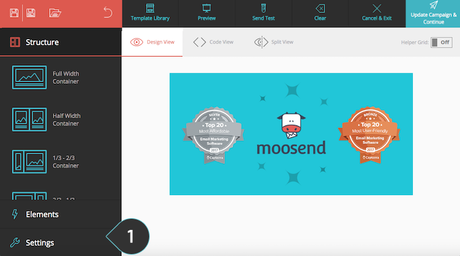
Mailchimp:
- Mailchimp has an old-fashioned drag-and-drop interface with simple templates to understand and use.
- With Mailchimp’s visual customer journey builder, you can create automated workflows quickly.
- You may link your Mailchimp account to a related Instagram or Facebook business account, allowing you to submit photographs from your social media accounts to utilise in your emails without having to open multiple tabs.
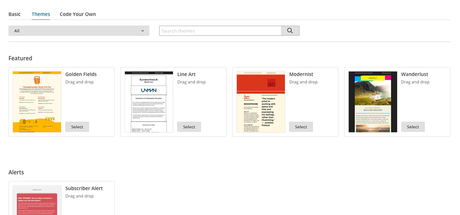
Verdict: In the Moosend vs Mailchimp debate, when it comes to easy usage, Moosend has a slight edge over Mailchimp because of its easy-to-navigate website and straightforward layout.
2.Moosend Vs. Mailchimp: Managing Email List 2.Moosend Vs. Mailchimp: Managing Email List
Moosend:
- Standard segmentation tools are available in Moosend; for example, you can structure your email list depending on fundamental demographics like age and gender.
- You may break your lists based on whether visitors viewed a product, made a purchase, or abandoned their basket using advanced segmentation options.
- Moosend takes email segmentation a step further by allowing you to segment your list based on whether recipients opened emails about all of your campaigns, opened emails about specific campaigns, clicked links in the body of your emails, or didn’t open any of your emails at all.
- Weather-based segmentations are now included in Moosend! As the name implies, this one-of-a-kind feature allows you to send weather-specific content. You can send automated product suggestions to meet your audience’s weather-related needs regardless of where they are located or whether the climate is hot or cold.
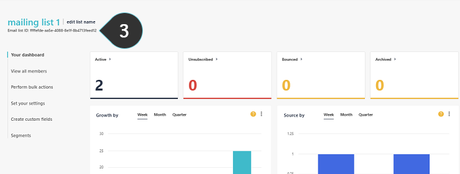
Mailchimp:
- Mailchimp allows you to segment your email lists based on subscriber data, engagement history with your brand, custom form fields and tags, and predictive insights based on subscriber behavior.
- Mailchimp can be used in conjunction with one of the company’s supported eCommerce store builders, which can segment your list based on product views and purchases.
- Mailchimp also has a lookalike audience finder that analyses your CRM data and its vast audience network to find contacts that have similar characteristics to your current customers. After you’ve created a lookalike audience, you can use Facebook or Instagram advertisements to reach out to them.
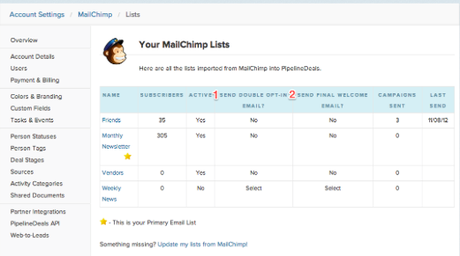
Verdict: Overall, in the Moosend vs Mailchimp debate, Mailchimp triumphs because of its advanced features, such as complex segmentation criteria, which allow you to send ultra-relevant material to your target.
3.Moosend Vs. Mailchimp: Automation To Streamline Marketing 3.Moosend Vs. Mailchimp: Automation To Streamline Marketing
Moosend:
- Users may automate their marketing communications using Moosend to guarantee that they reach customers at best possible conversion time.
- Subscribers receive automated communications as a result of many triggers and conditional filters.
Example: To persuade the recipient to return and complete their purchase, you may send an automatic abandoned cart email. You might also offer product recommendations to existing clients based on their purchase history.
- You may also generate personalised emails, schedule them to go out automatically on specific days/months, and define time intervals between emails to ensure that your consumers aren’t bombarded with your information.
- Moosend offers a variety of marketing automation templates that you can personalise, expand on, and save for future campaigns.

Mailchimp:
- Mailchimp’s automation features aren’t available under the freemium package and can only be used if you have a paid membership. On the other hand, Paid subscribers can access various automation options, including Mailchimp’s new customer journeys feature.
- Automated transactional email, time-optimised emails, date-based automation (customer birthdays, anniversaries, special holidays), welcome emails, and abandoned cart emails are other automation features.
- With Mailchimp’s visual drag-and-drop editor, all automated workflows are straightforward to set up. It lets you respond to various traditional triggers based on a given date, event, or contact behavior. Mailchimp, unlike Moosend, does not include automation templates.

Verdict: In the Moosend vs Mailchimp debate, with its pre-built templates, Moosend makes automation a little bit easier. Automations must function in tandem with the email templates and available segmentation choices.
4.Moosend Vs. Mailchimp: Reporting and Analytics To Study Engagement 4.Moosend Vs. Mailchimp: Reporting and Analytics To Study Engagement
Moosend:
- Users can build reports in Moosend that provide a broad and detailed perspective of client activity, including open, click-through, forward, unopened, bounce, and unsubscribe rates for your campaign.
- All of your receivers’ actions are logged in one central location, allowing you to assess individual campaigns’ effectiveness swiftly.
- You’ll also get statistics on the effectiveness of your email links, the device types that recipients use to check your emails, the internet browsers that recipients use to interact with your emails, the country location and where recipients are located within that country and your top-spending customers.
- You may also track and interpret your contacts’ clicks, stops, and scrolling to have a better picture of their audience.
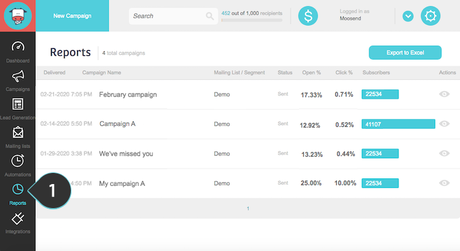
Mailchimp:
- The Audience Analytics Dashboard in Mailchimp allows you to track client data, notice trends and take action based on those findings. All the statistics are updated in real-time so you can observe what’s working well.
- You can also generate reports on growth, engagement, and revenue with Mailchimp. You can view how many recipients clicked on your email links, bought anything, or downloaded something, and compare your results to your competitors.
- Mailchimp has a mobile application that allows you to see all your data and reports while traveling.
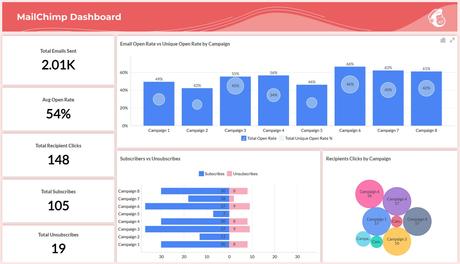
Verdict: In the Moosend vs Mailchimp debate, Moosend comes out as the winner because of its intuitive and highly visual analytics interface that allows users to study insights and strategise their campaigns quickly.
5.Moosend Vs. Mailchimp: Seamlessly Integrates With Your Current Tech Stack 5.Moosend Vs. Mailchimp: Seamlessly Integrates With Your Current Tech Stack
Moosend:
- Moosend offers an extensive library of plugins in various categories (CRM, eCommerce, lead generation, list validations, and more) when it comes to integrations. WordPress, WooCommerce, Elementor, Drupal, HubSpot, PrestaShop, and many others are among the 79 integrations available.
- You can also import your Mailchimp email list into Moosend!
- In 2020, Moosend launched its web API, allowing software developers to establish their bespoke integrations within the Moosend infrastructure.

Mailchimp:
- Mailchimp, like Moosend, offers a large number of integrations spanning a wide range of areas like lead generation, reservations and events, social networking platforms, live chat and SMS messaging, and more.
- WordPress, WooCommerce, Adobe, Eventbrite, Hootsuite, Calendly, Facebook, Twitter, and others are Mailchimp’s most popular integrations. Furthermore, Zapier integration allows you to connect with and use hundreds of third-party applications. Nevertheless, you must pay an additional fee to access this option.
- Mailchimp has an open API to construct your custom integrations.
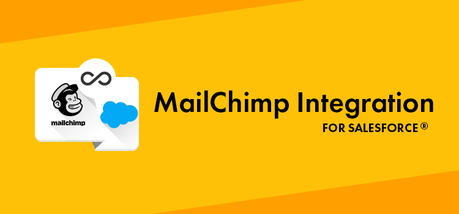
Verdict: In the Moosend vs Mailchimp debate, Mailchimp has the upper hand because they offer an even more comprehensive range of plugins, particularly in the marketing and data analytics fields.
6.Moosend Vs. Mailchimp: A/B Testing 6.Moosend Vs. Mailchimp: A/B Testing
Moosend:
- The A/B testing function in Moosend lets you design two campaigns, which you can launch right away or plan for later.
- You can use the Moosend campaign editor or an external HTML source to produce the material. The most popular campaign will be sent to the most people. You may configure your A/B campaign and choose the winning version with Moosend via two methods:
-Campaign: Most Unique Opens
-Campaign: Most Unique Clicks
- You can also choose how long the test will run before sending the winner version.
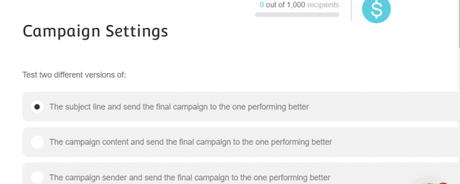
Mailchimp:
- If you have a list of at least 5,000 people, Mailchimp recommends A/B testing to achieve statistical significance. If your list is smaller, you may still do the tests and utilise the data to determine which communications method is most effective.
- Preheaders and subject lines, calls-to-action, imagery, and send time may all be tested in Mailchimp. You have the option to choose how Mailchimp chooses the winner:
-For Testing Subject line: Send Time & Open Rate
-For Testing Content: Click Rate

Verdict: In the Moosend vs Mailchimp debate, Mailchimp is the winner because it allows you to test three different campaign versions, whereas Moosend only will enable you to test two. Mailchimp’s Multivariate testing functionality also allows you to test up to eight different campaign variations.
7.Moosend Vs. Mailchimp: Customer Support 7.Moosend Vs. Mailchimp: Customer Support
Moosend:
- You’ll discover many self-help resources on the Moosend website, including blogs, webinars, infographics, and their online support center. You can go through their extensive collection of FAQs, which are organised in a user-friendly manner and cover a wide range of topics.
- On its website, Moosend also offers an “Academy” section. From this page, you may get free online courses on several topics, including how to move your brick-and-mortar business online, eCommerce, publishing, and more.
- Moosend provides dedicated customer support via various channels, including phone, live chat, and email, and there is no additional charge for any level of service.
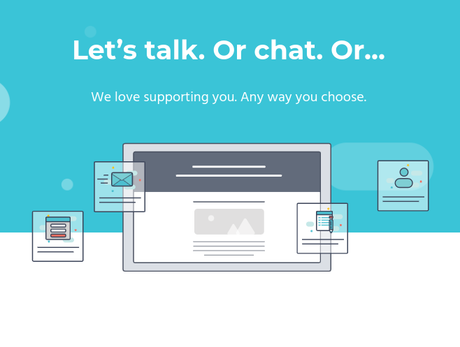
Mailchimp:
- How-to tutorials and guides, marketing tips, branding guides, audience growth guides, expert insights, podcasts, series, and films from various contributors are available on Mailchimp’s website.
- Mailchimp’s customer service team can be reached via live chat or email. Both chat and email assistance are available 24 hours a day, seven days a week from the Essentials package forward. The Premium Plan has phone assistance, accessible Monday through Friday from 9 AM to 5 PM ET.
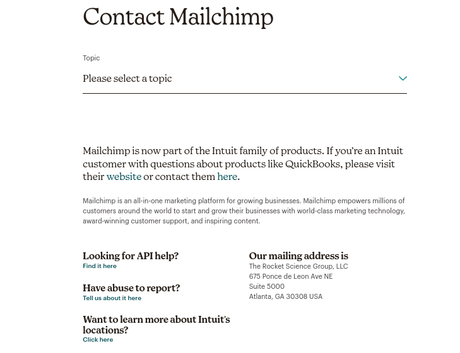
Verdict: In the Moosend vs Mailchimp debate, clearly, it is Moosend because free plan users get access to the phone, live chat, and email help, whereas Mailchimp’s pricey premium plan requires a subscription to access all support channels.
8.Moosend Vs. Mailchimp: Pricing 8.Moosend Vs. Mailchimp: Pricing
Moosend:
You can pay monthly or annual with Moosend; the choice is yours. It’s worth noting that you’ll get a discount if you pay for a year in advance. They also provide a 30-day no-risk free trial that includes all of Moosend’s enterprise-level capabilities.
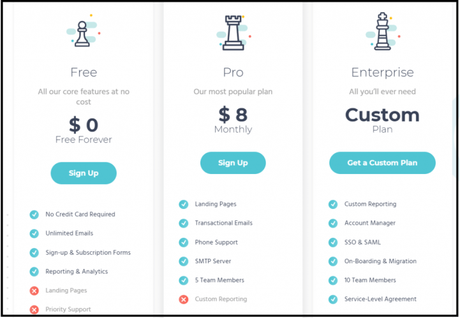
Moosend’s Plans:
The Pro Plan:
The Pro plan, which costs $7 a month if paid annually (or $9 if paid monthly), permits you to add up to 500 subscribers to your list. The price rises as the number of members grow. The plan features:
-Unlimited Emails
-Automation Workflows
-Landing Pages / Forms
-SMTP Server
-Transactional Emails (Triggered by Customer Actions)
-Reporting & Analytics Features
-Registering up to 5 Members
The Enterprise Plan:
You’ll have to contact Moosend’s sales support directly because this is a customised plan. The Enterprise Plan is a one-stop-shop, custom-tailored to your unique requirements and priced appropriately. It features:
-All-Pro features
-Account Manager
-Priority Support
-SSO & SAML
-Dedicated IP
Mailchimp:

Mailchimp Monthly Payment Plans:
The Free Plan:
-Up To 2,000 Contacts
-Signup Forms, Landing Pages, & Website Builder
-Daily Limit Of 2,000 Sends & Monthly Limit Of 10,000.
-Access To Mailchimp’s CRM, Creative Assistant, AI-Powered Design Tool
The Essentials Plan:
With $11, you’ll get everything in the freemium plan plus the following:
-Up To 50,000 Contacts
-Email Templates
-Customer Journey Builder
-A/B Testing For Custom Branding
The Standard Plan:
You’ll get everything described above, plus the following for $17 per month:
-100,000 Contacts
-Branching Point Builder & Customer Journey Builder
-Point Of Delivery Optimization & Behavioural Targeting
-Personalised Templates
-Dynamic Content
The Premium Plan:
With a monthly subscription of $299, you’ll gain access to more advanced tools and a greater degree of personalisation. You get everything listed above, plus:
-Over 200,000 Contacts
-More Sophisticated Segmentation
-Comparative Reporting And Multivariate Testing
-Unlimited Seats And Access Based On Role
-Telephone Assistance
Verdict: In the Moosend vs Mailchimp debate, Moosend deserves the trophy because there are no surprises with Moosend’s price system, which is essential and easy to grasp. Most users only have to worry about one premium subscription, making Moosend’s basic features more accessible. It also doesn’t make things more complicated by charging extra for transactional emails and includes it in its pricing.
Moosend vs Mailchimp: Which Email Marketing Software is suitable for the growth of my business? Moosend vs Mailchimp: Which Email Marketing Software is suitable for the growth of my business?
If you’re on a tight budget, start with Moosend because it’s less expensive than Mailchimp when the functionality and price are weighed against the size of the contact lists.
Mailchimp is a good option for small firms and entrepreneurs because it provides a comprehensive collection of tools and integrations.
Due to incorporating Ecommerce AI, Moosend is ideal for customers who have physical stores or online shops. Automation features such as cart abandonment, cross-selling, product recommendations, and integrations are all included in this feature.
Suppose your online activity requires more fundamental activities like establishing a blog. In that case, Mailchimp is an ideal location to familiarise yourself with the many functions.
Moosend vs Mailchimp: Final Verdict: Moosend vs Mailchimp: Final Verdict:
Following a thorough comparison of Moosend and Mailchimp, it is clear that Moosend is the clear champion. Instead of the outdated appearance and feel of Mailchimp, Moosend provides a modern and elegant interface for email generation. Moosend is also a less expensive option with a lot of appealing features. In terms of ease of use, cost, automation, and templates, Moosend have a slight edge over Mailchimp. However, the best option is entirely dependent on the capabilities your company requires.
GET YOUR MOOSEND SUBSCRIPTION NOW!
